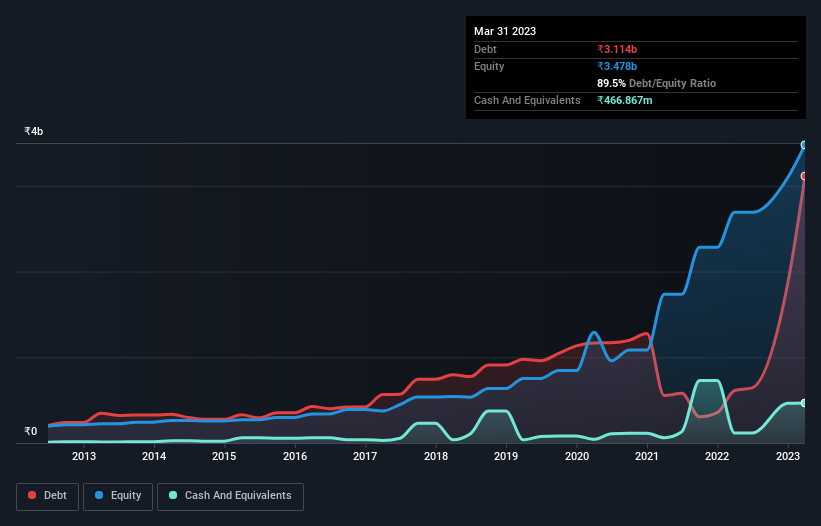
Warren Buffett famously said, 'Volatility is far from synonymous with risk.' When we think about how risky a company is, we always like to look at its use of debt, since debt overload can lead to ruin. We note that Gufic Biosciences Limited (NSE:GUFICBIO) does have debt on its balance sheet. But is this debt a concern to shareholders?
What Risk Does Debt Bring?
Debt and other liabilities become risky for a business when it cannot easily fulfill those obligations, either with free cash flow or by raising capital at an attractive price. Part and parcel of capitalism is the process of 'creative destruction' where failed businesses are mercilessly liquidated by their bankers. However, a more common (but still painful) scenario is that it has to raise new equity capital at a low price, thus permanently diluting shareholders. Of course, debt can be an important tool in businesses, particularly capital heavy businesses. When we examine debt levels, we first consider both cash and debt levels, together.
Check out our latest analysis for Gufic Biosciences
How Much Debt Does Gufic Biosciences Carry?
As you can see below, at the end of March 2023, Gufic Biosciences had ₹3.11b of debt, up from ₹612.4m a year ago. Click the image for more detail. However, because it has a cash reserve of ₹466.9m, its net debt is less, at about ₹2.65b.

How Strong Is Gufic Biosciences' Balance Sheet?
Zooming in on the latest balance sheet data, we can see that Gufic Biosciences had liabilities of ₹2.88b due within 12 months and liabilities of ₹2.25b due beyond that. Offsetting these obligations, it had cash of ₹466.9m as well as receivables valued at ₹2.06b due within 12 months. So it has liabilities totalling ₹2.61b more than its cash and near-term receivables, combined.
Of course, Gufic Biosciences has a market capitalization of ₹22.5b, so these liabilities are probably manageable. However, we do think it is worth keeping an eye on its balance sheet strength, as it may change over time.
In order to size up a company's debt relative to its earnings, we calculate its net debt divided by its earnings before interest, tax, depreciation, and amortization (EBITDA) and its earnings before interest and tax (EBIT) divided by its interest expense (its interest cover). Thus we consider debt relative to earnings both with and without depreciation and amortization expenses.
Gufic Biosciences's net debt to EBITDA ratio of about 2.0 suggests only moderate use of debt. And its strong interest cover of 13.7 times, makes us even more comfortable. The bad news is that Gufic Biosciences saw its EBIT decline by 13% over the last year. If earnings continue to decline at that rate then handling the debt will be more difficult than taking three children under 5 to a fancy pants restaurant. The balance sheet is clearly the area to focus on when you are analysing debt. But you can't view debt in total isolation; since Gufic Biosciences will need earnings to service that debt. So if you're keen to discover more about its earnings, it might be worth checking out this graph of its long term earnings trend.
Finally, while the tax-man may adore accounting profits, lenders only accept cold hard cash. So we clearly need to look at whether that EBIT is leading to corresponding free cash flow. During the last three years, Gufic Biosciences burned a lot of cash. While that may be a result of expenditure for growth, it does make the debt far more risky.
Our View
Gufic Biosciences's conversion of EBIT to free cash flow and EBIT growth rate definitely weigh on it, in our esteem. But its interest cover tells a very different story, and suggests some resilience. When we consider all the factors discussed, it seems to us that Gufic Biosciences is taking some risks with its use of debt. While that debt can boost returns, we think the company has enough leverage now. The balance sheet is clearly the area to focus on when you are analysing debt. However, not all investment risk resides within the balance sheet - far from it. Case in point: We've spotted 2 warning signs for Gufic Biosciences you should be aware of.
Of course, if you're the type of investor who prefers buying stocks without the burden of debt, then don't hesitate to discover our exclusive list of net cash growth stocks, today.
New: Manage All Your Stock Portfolios in One Place
We've created the ultimate portfolio companion for stock investors, and it's free.
• Connect an unlimited number of Portfolios and see your total in one currency
• Be alerted to new Warning Signs or Risks via email or mobile
• Track the Fair Value of your stocks
Have feedback on this article? Concerned about the content? Get in touch with us directly. Alternatively, email editorial-team (at) simplywallst.com.
This article by Simply Wall St is general in nature. We provide commentary based on historical data and analyst forecasts only using an unbiased methodology and our articles are not intended to be financial advice. It does not constitute a recommendation to buy or sell any stock, and does not take account of your objectives, or your financial situation. We aim to bring you long-term focused analysis driven by fundamental data. Note that our analysis may not factor in the latest price-sensitive company announcements or qualitative material. Simply Wall St has no position in any stocks mentioned.
About NSEI:GUFICBIO
Gufic Biosciences
Manufactures and markets active pharmaceutical ingredients (APIs), generic pharmaceuticals, and related services in India, Africa, Asia, Europe, Australia, North America, South America, and internationally.
Excellent balance sheet with questionable track record.
Market Insights
Community Narratives




